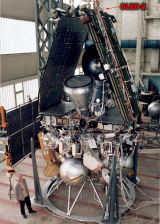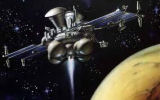








|
Mars-96
The Mars '96 Mission was initially
funded as Mars '92 than Mars '94 by the Soviet Union, before the union
ended in 1991. The Mars 96 spacecraft was built around the PHOBOS-type
spacecraft structure. The Russian Mars 96 mission was designed to send
an orbiter, two small autonomous stations, and two surface penetrators
to Mars to investigate the evolution and contemporary physics of the
planet by studying the physical and chemical processes which took place
in the past and which currently take place. The Mars 96 Orbiter was a
3-axis sun/star stabilized craft design with two platforms for pointing
and stabilizing instruments. The propulsion units were mounted on the
bottom and two large solar panels extended out from opposite sides of
the craft. The two penetrators were mounted on the bottom by the
propulsion system, the two small stations were connected on top of the
spacecraft, and a dish antenna extended off one of the sides
perpendicular to the solar panels. The Mars 96 spacecraft had a launch
mass (including propellant) of 6180 kg.
The Mars 96 Orbiter carried 12 instruments to study
the surface and
atmosphere of Mars, 7 instruments to study plasma, fields, and
particles, and 3 instruments for astrophysical studies. There were also
radio science, a navigation TV camera, and a radiation and dosimetry
control complex. The instruments were located directly on the sides of
the craft, on one of the two platforms attached to the sides of the
craft, or on the edges of the solar panels.
Our human resources had been participating in
completing three
different experiments to study the plasma and magnetic fields. They had
developed some onboard software and the EGSEs. The first equipment (MAREMF) would
have studied the distribution of electrons around Mars,
the magnetic field of Mars and the interaction between the electrons
and the magnetic field. The MARIPROB
experiment would have examined the
parameters of ionosphere of the planet while the third experiment (SLED-2) the
high-energy particles of the environment of Mars.
The Mars 96 spacecraft was launched into Earth orbit
but failed to
achieve insertion into Mars cruise trajectory and re-entered the
Earth’s atmosphere on 17 November 1996 and crashed within a presumed
320 km by 80 km area which includes parts of the Pacific Ocean Chile,
and Bolivia. The cause of the crash is not known.
4. March
2014
|

Mars96
s/c
integration
before
Bajkonur

Mars96
s/c at Mars
(work of artist)
|


